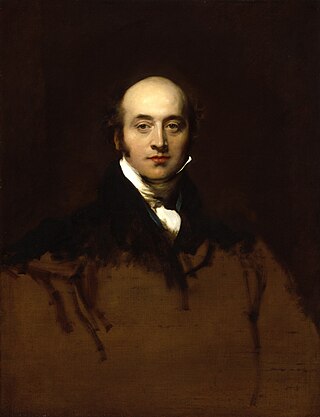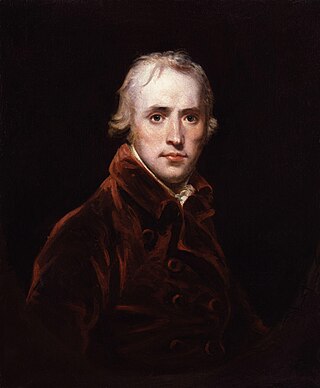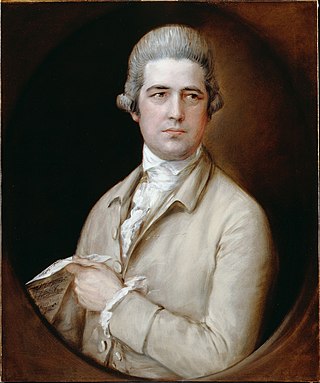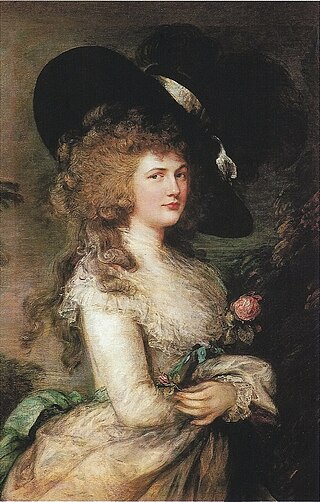
Thomas Gainsborough was an English portrait and landscape painter, draughtsman, and printmaker. Along with his rival Sir Joshua Reynolds, he is considered one of the most important British artists of the second half of the 18th century. He painted quickly, and the works of his maturity are characterised by a light palette and easy strokes. Despite being a prolific portrait painter, Gainsborough gained greater satisfaction from his landscapes. He is credited as the originator of the 18th-century British landscape school. Gainsborough was a founding member of the Royal Academy.

Sir Thomas Lawrence was an English portrait painter and the fourth president of the Royal Academy. A child prodigy, he was born in Bristol and began drawing in Devizes, where his father was an innkeeper at the Bear Hotel in the Market Square. At age ten, having moved to Bath, he was supporting his family with his pastel portraits. At 18, he went to London and soon established his reputation as a portrait painter in oils, receiving his first royal commission, a portrait of Queen Charlotte, in 1789. He stayed at the top of his profession until his death, aged 60, in 1830.

John Singer Sargent was an American expatriate artist, considered the "leading portrait painter of his generation" for his evocations of Edwardian-era luxury. He created roughly 900 oil paintings and more than 2,000 watercolors, as well as countless sketches and charcoal drawings. His oeuvre documents worldwide travel, from Venice to the Tyrol, Corfu, Capri, Spain, the Middle East, Montana, Maine, and Florida.

Maria Anna Angelika Kauffmann, usually known in English as Angelica Kauffman, was a Swiss Neoclassical painter who had a successful career in London and Rome. Remembered primarily as a history painter, Kauffman was a skilled portraitist, landscape and decoration painter. She was, along with Mary Moser, one of two female painters among the founding members of the Royal Academy in London in 1768.

Richard Brinsley Butler Sheridan was an Anglo-Irish playwright, writer and Whig politician who sat in the British House of Commons from 1780 to 1812, representing the constituencies of Stafford, Westminster and Ilchester. The owner of the Theatre Royal, Drury Lane, in London, he wrote several prominent plays such as The Rivals (1775), The Duenna (1775), The School for Scandal (1777) and A Trip to Scarborough (1777). He served as Treasurer of the Navy from 1806 to 1807. Sheridan died in 1816 and was buried at Poets' Corner in Westminster Abbey. His plays remain a central part of the Western canon and are regularly performed around the world.

John Hoppner was an English portrait painter, much influenced by Reynolds, who achieved fame as a colourist.

Thomas Linley was an English bass and musician active in Bath, Somerset. Born in Badminton, Gloucestershire, Linley began his musical career after he moved to Bath at age 11 and became apprentice to the organist Thomas Chilcot. After his marriage to Mary Johnson in 1752, Linley at first supported his wife and growing family predominantly as a music teacher. As his children grew and he developed their musical talent, he drew an increasing amount of income from their concerts while also managing the assembly rooms in Bath. When the new Bath Assembly Rooms opened in 1771, Linley became musical director and continued to promote his children's careers. He was eventually able to move to London with the thousands of pounds which he had amassed from their concerts.

Mr and Mrs Andrews is an oil on canvas portrait of about 1750 by Thomas Gainsborough, now in the National Gallery, London. Today it is one of his most famous works, but it remained in the family of the sitters until 1960 and was very little known before it appeared in an exhibition in Ipswich in 1927, after which it was regularly requested for other exhibitions in Britain and abroad, and praised by critics for its charm and freshness. By the post-war years its iconic status was established, and it was one of four paintings chosen to represent British art in an exhibition in Paris celebrating the Coronation of Queen Elizabeth II in 1953. Soon the painting began to receive hostile scrutiny as a paradigm of the paternalist and capitalist society of 18th-century England, but it remains a firm popular favourite.
Walter Long of South Wraxall, near Bradford-on-Avon, the great-great-great grandson of Sir Walter Long of South Wraxall and Draycot, was born in Wiltshire, and inherited along with other family estates, the 15th-century house known as South Wraxall Manor. His ancestors made their wealth initially as clothiers. He served as High Sheriff of Wiltshire for 1764.

Elizabeth Ann Sheridan was an English singer who was known to have possessed great beauty. She was the subject of several paintings by Thomas Gainsborough, who was a family friend, Joshua Reynolds and Richard Samuel. An adept poet and writer, she became involved with the Blue Stockings Society and participated in Whig politics.

Maria Linley was an English singer.

Pinkie is the traditional title for a portrait made in 1794 by the English painter Thomas Lawrence. It is now in the Huntington Library at San Marino, California where it normally hangs opposite The Blue Boy by Thomas Gainsborough. The title now given it by the museum is Sarah Goodin Barrett Moulton: "Pinkie". These two works are the centerpieces of the institution's art collection, which has notable holdings of eighteenth-century British portraiture. The painting is an elegant depiction of Sarah Moulton (1783–1795), who was about eleven years old when painted. Her direct gaze and the loose, energetic brushwork give the portrait a lively immediacy.

The Duenna is a three-act comic opera, mostly composed by Thomas Linley the elder and his son, Thomas Linley the younger, to an English-language libretto by Richard Brinsley Sheridan. At the time, it was considered one of the most successful operas ever staged in England, and its admirers included Samuel Johnson, William Hazlitt and George Byron.

Richard Samuel was an English portrait painter who won several prestigious medals in the 1770s in London. He is known for a small number of paintings including what came to be known as The Nine Living Muses of Great Britain of 1778 in which he painted the nine leading blue stocking women of his time.

Portrait of Georgiana, Duchess of Devonshire is a portrait painting by the English painter Thomas Gainsborough of the political hostess Georgiana Cavendish, Duchess of Devonshire. It was painted between 1785 and 1787.

Thomas Sheridan was the only son of the Irish playwright and poet Richard Brinsley Sheridan and the soprano Elizabeth Ann Linley, although his father had at least one other son from a second marriage. Born in mid-November 1775, Sheridan initially tried for a career in politics but was unsuccessful.
Edward Bouverie, the eldest son of Edward Bouverie senior MP, of Delapré Abbey, Hardingstone, Northamptonshire, and Harriet Fawkener a political hostess and socialite. He married Catherine Castle, heiress and daughter of William Castle of Suffolk in March 1788. They had 4 sons and 4 daughter.

Mr and Mrs William Hallett is a 1785 oil on canvas painting by the British painter Thomas Gainsborough, and is now in the collection of the National Gallery in London.

Portrait of Mrs Mary Graham or The Honourable Mrs Graham is a 1777 oil on canvas painting by the British artist Thomas Gainsborough, produced shortly after Mary's marriage to Thomas Graham, the future Lord Lynedoch on 26 December 1774. It was one of the first works to enter the collection of the Scottish National Gallery in Edinburgh after its bequest in 1859 by the heirs of Thomas Graham.

Portrait of Anne, Countess of Chesterfield is a large oil-on-canvas painting by the English portrait and landscape artist Thomas Gainsborough, completed between 1777 and 1778. It shows Anne Stanhope, wife of Philip Stanhope, 5th Earl of Chesterfield, sitting in a blue and white satin dress, sitting in a garden, and is one of the best known of Gainsborough's many portraits of English aristocrats.


















